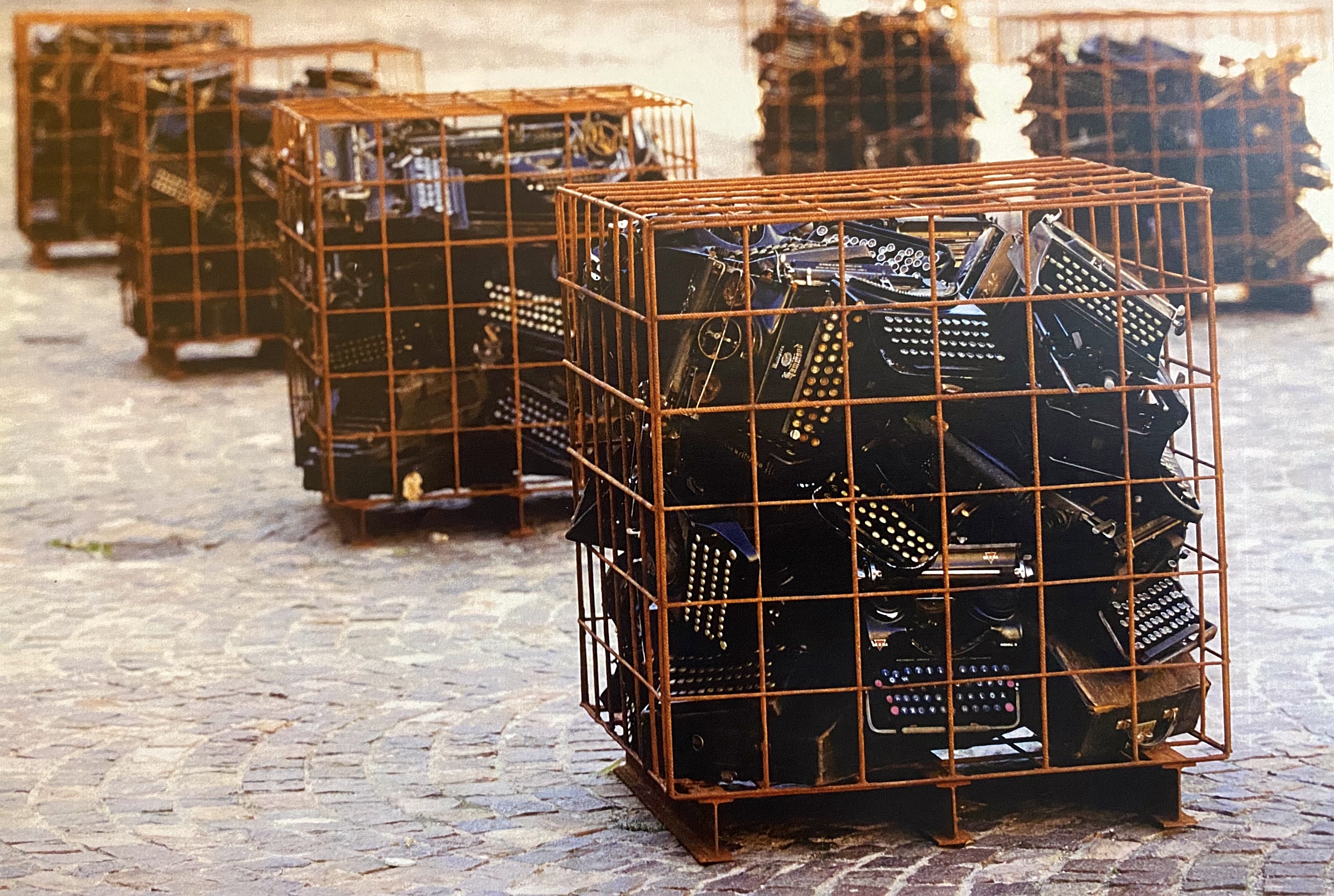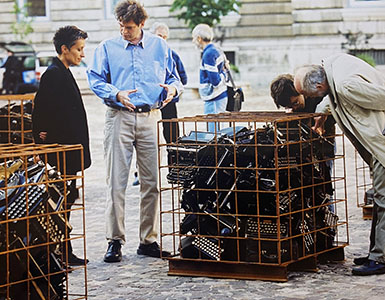
Sheryl Oring
WRITER’S BLOCK

Sheryl Oring is an American artist who was living in Germany where she presented Writer’s Block on the site of the Berlin book burning as a dramatic reminder of that horrific historical event. Oring created 21 steel cages filled with 600 vintage typewriters collected from Germany, England, Hungary, the Czech Republic and the United States. Each sculpture is one cubic yard in size and weighs nearly half a ton. Tom Freudenheim, Deputy Director of the Jewish Museum Berlin at the time of the exhibition, wrote, “This is one of those rare art works which succeeds on both aesthetic and political terms.”
The exhibition drew international attention to censorship that exists even today in the U.S. As Cultural Exchange Foundation travelled Writers’ Block to Hungary and the United States, each with its own history regarding issues of censorship, the artwork gained new meaning. Hungarian President Árpád Göncz opened the Budapest exhibition. Göncz, himself a writer and literary translator, was imprisoned for six years for his role in the Hungarian revolution of 1956. He was joined by prominent Hungarian writers, artists, actors, musicians and others who struggled for the right of free expression during the Communist era.
(selected photos – LIONS’ COURT, Budapest)
The Budapest location for the exhibition was the Lions’ Courtyard of the Buda Castle, in front of the National Széchényi Library and surrounded by the Budapest Ludwig Museum, Budapest Historical Museum and the Hungarian National Gallery.
(selected photos – LIONS’ COURT, Budapest)
“Let us be reminded by these imprisoned typewriters, that standing up to censorship is our collective responsibility. No one has the right to use fear as an excuse to annihilate or diminish others’ freedom of thought.”
--Hungarian President Árpád Göncz
In addition to Budapest, Cultural Exchange Foundation organized the exhibition in New York’s Bryant Park, adjacent to the New York Library’s main branch, and at the Boston Public Library, the nation’s oldest public library. Writers’ Block was the central visual element of Words on Fire, a Boston festival celebrating freedom of expression. The Boston Globe wrote, “These tangled typewriters bespeak an asphyxiated expression that’s different from the silent shelves of the Opernplatz: lying in heaps of snarled parts, the keys want tapping, but fierce angles and metal bars prevent it.”
(selected photos from BOSTON PUBLIC LIBRARY)
Visitors and students typing on old typewriters from cages as part of the interactive exhibition at Boston Public Library
“Every month books are being challenged in school libraries and curricula across the United States. Writers’ Block has the potential of bringing attention to present day battles over controversial artistic expression.”
–Svetlana Mintcheva, Arts Advocacy Project Coordinator, National Coalition Against Censorship, New York
Bryant Park was selected because of its historical relevance: in 1943, on the 10th anniversary of the Nazi book burning, thousands of New Yorkers gathered outside the New York Public Library to protest. The New York Times wrote, “The exhibition goes beyond being another commemoration of a long-ago book burning.”
The powerful visual metaphor of the caged typewriters reflected a poignant reminder of contemporary censorship, where historic book burning has become histrionic book banning in several American states.
(selected photos from BRYANT PARK, New York)
Artist Sheryl Oring who created the exhibition told the New York Times, “It also makes reference to the exile experience since so many of those German writers came to America.” Also from the Times:
“ ‘It’s a very interactive piece,’ said Anita Semjen, who runs the Cultural Exchange Foundation in Washington, ‘Kids reached into the cages to touch the keys. Some people took out a piece of paper from their pockets and began to type on it.’ “
“This installation provokes the thought that a victim may have written on one of these machines. They are the silent witnesses to censorship.”
– Brigette Kaiser-Derenthal, Director, Goethe Institute, Budapest






















